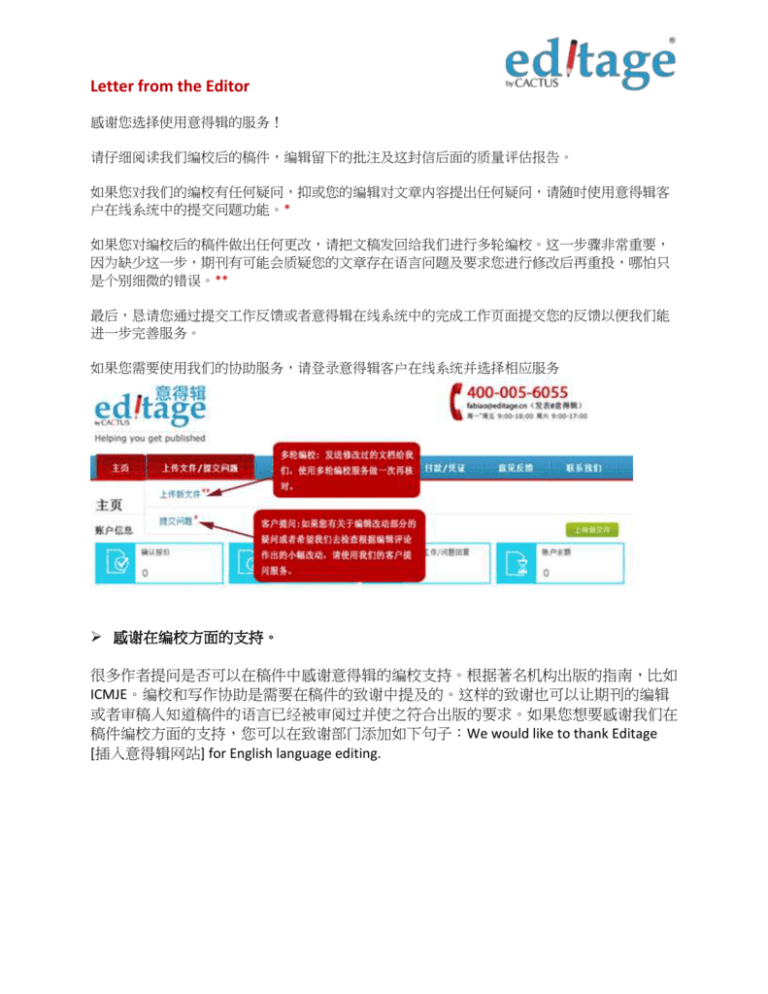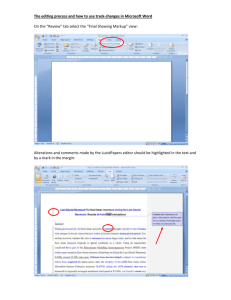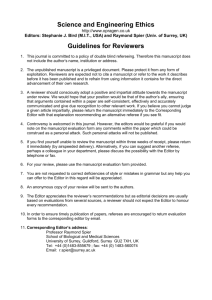Letter from the Editor 感谢您选择使用意得辑的服务! 请仔细阅读我们
advertisement

Letter from the Editor 感谢您选择使用意得辑的服务! 请仔细阅读我们编校后的稿件,编辑留下的批注及这封信后面的质量评估报告。 如果您对我们的编校有任何疑问,抑或您的编辑对文章内容提出任何疑问,请随时使用意得辑客 户在线系统中的提交问题功能。* 如果您对编校后的稿件做出任何更改,请把文稿发回给我们进行多轮编校。这一步骤非常重要, 因为缺少这一步,期刊有可能会质疑您的文章存在语言问题及要求您进行修改后再重投,哪怕只 是个别细微的错误。** 最后,恳请您通过提交工作反馈或者意得辑在线系统中的完成工作页面提交您的反馈以便我们能 进一步完善服务。 如果您需要使用我们的协助服务,请登录意得辑客户在线系统并选择相应服务 感谢在编校方面的支持。 很多作者提问是否可以在稿件中感谢意得辑的编校支持。根据著名机构出版的指南,比如 ICMJE。编校和写作协助是需要在稿件的致谢中提及的。这样的致谢也可以让期刊的编辑 或者审稿人知道稿件的语言已经被审阅过并使之符合出版的要求。如果您想要感谢我们在 稿件编校方面的支持,您可以在致谢部门添加如下句子:We would like to thank Editage [插入意得辑网站] for English language editing. Letter from the Editor From your editor, Minal Dear Author, It was a pleasure working on your document. As requested, I have formatted the manuscript according to the guidelines of American Journal of Hematology. I have suggested extensive revisions for some parts of the manuscript. I strongly recommend that you submit the manuscript for another round of editing after accepting/rejecting these changes. This would ensure that all issues are resolved and would yield a more polished manuscript. Do go through my changes as well as comments and additional notes in this file. Please send me your feedback or any questions through your Editage Online account (http://online.editage.cn/). Letter from the Editor Editor’s Report I have provided feedback through ratings for each section, along with any specific comments. The key alongside explains my ratings. I hope you find my feedback useful! This section required only a few revisions. Most parts of this section required revision. The entire section required significant revision. Please go through my comments/changes carefully. HOW TO WRITE… The title An effective title is concise while being representative. RATING FEEDBACK ON YOUR DOCUMENT The title should convey the main objective or finding of the study. I have recommended a revised concise title for The abstract A good abstract explains the aims of the research, how these were met, and the main findings. NA The introduction This section should set the context for the study, clearly state the research objective, and establish the significance of the study. The materials & methods This section should completely describe all methods, techniques, and instruments used. This includes ethical considerations. The results & discussion These sections should present the data and findings in clear and unbiased manner, and address the objective or research question stated in the introduction. your manuscript. Please include an abstract for the manuscript. The “Introduction” section required significant restructuring to improve the logical flow of the section. I have reorganized this section by modifying your sentences and also by including new information. Begin this section by describing HCT and ES, followed by description of the lack of consensus of criteria to define ES. This section should provide information required to frame the study objectives in a clear and concise manner. The concluding paragraph of this section should outline the study objectives. Overall, the “Methods” section provides considerable detail of the study. To further improve this section, please define all the study groups (ES, non-ES, MRD, MUD) Letter from the Editor mentioned in the “Results” and “Discussion” sections. The “Results” and “Discussion” sections were well written. However, the results section should be concise summarizing only the main findings. The “Discussion” section can be further improved by deleting text that pertains to defining study objectives and by focusing on the interpretation of results. Table(s) & Figures The tables and figures should present data clearly, should be referenced in and correspond with the text. Please define all the abbreviations used in the tables in the footnote to the tables. Letter from the Editor A QUICK TIP GUIDELINE Provide full-form of all abbreviations at first mention. EXPLANATION Typically, unless the journal has a list of standard abbreviations (which can be used without definition), all abbreviations are defined at their first mention in the document, with the abbreviation introduced within parentheses. At subsequent mentions of the term, the abbreviation is used consistently. In addition, if an abbreviation is only mentioned once in the manuscript, the abbreviation is unnecessary and only the full form must be provided. EXAMPLE Several abbreviations (MRD, MUD, MSD) were not defined at first mention.





